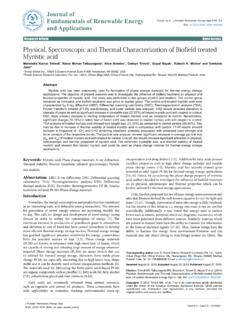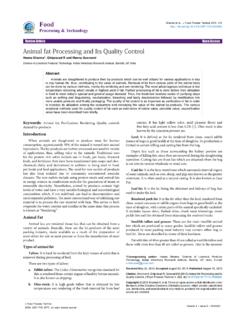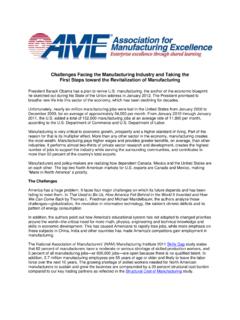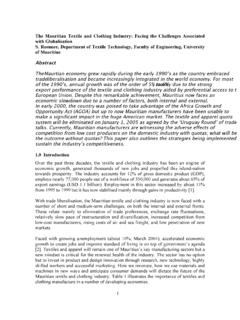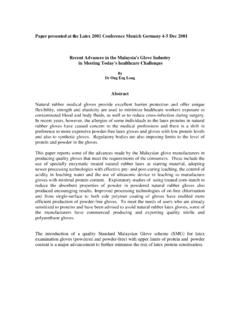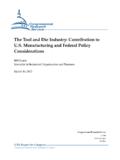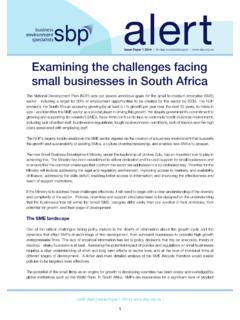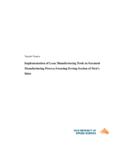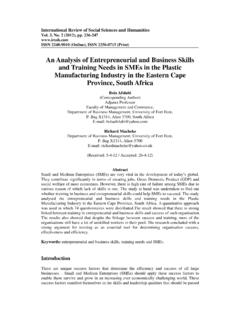Transcription of Food Processing Industry in India: S&T Capability, Skills ...
1 Volume 4 Issue 9 1000260J Food Process TechnolISSN: 2157-7110 JFPT, an open access journal Open AccessReview ArticleRais et al., J Food Process Technol 2013, 4:9 DOI: : Food Processing Industry ; S&T capability ; Policies; Skill developmentIntroductionFood Processing is the transformation of raw ingredients into food, or of food into other forms. Food Processing typically takes clean, harvested crops or butchered animal products and uses these to produce attractive, marketable and often long shelf-life food processed food Industry is divided into the following broad segments: Primary processed food - which includes products such asfruits and vegetables, packed milk, unbranded edible oil, milled rice, flour, tea, coffee, pulses, spices, and salt, sold in packed ornon-packed forms.
2 Value-added processed food - which includes productssuch as processed fruits and vegetables, juices, jams, pickles,squashes, processed dairy products (ghee, paneer, cheese, andbutter), processed poultry, and processed marine products,confectionary, chocolates, and alcoholic the world, food- Processing is considered to be a sunrise sector because of its large potential for growth and socio economic impact. It not only leads to income generation but also helps in reduction of wastage, value addition, and foreign exchange earnings and enhancing manufacturing competitiveness. In today s global market, quality and food safety have become competitive edge for the enterprises producing foods and providing services.
3 With proper investment in food Processing , technical innovation and infrastructure for agriculture sector, India could well become the food basket of the world [1]. The existing level of Processing and the extent of value addition are very low as compared to other developing countries. In India the food Processing Industry is ranked fifth in terms of production, consumption, export and expected growth [2]. A strong and dynamic *Corresponding author: Mohammad Rais, Senior Principal Scientist, CSIR-National Institute of Science, Technology & Development Studies (NISTADS), Pusa Gate, Krishnan Marg, New Delhi-110012, India, E-mail: Received July 12, 2013; Accepted September 03, 2013; Published September 10, 2013 Citation: Rais M, Acharya S, Sharma N (2013) Food Processing Industry in India: S&T capability , Skills and employment opportunities .
4 J Food Process Technol 4: 260. : 2013 Rais M, et al. This is an open-access article distributed under the terms of the Creative Commons Attribution License, which permits unrestricted use, distribution, and reproduction in any medium, provided the original author and source are paper provides a detailed analysis of food Processing Industry in India, its S&T capability , Skills and employment opportunities . Food Processing Industry is slowly and steadily becoming one of the major industries of our economy. Its share in GDP is on continuous rise, with a CAGR of , from 2005-06 to 2009-10. There has been a continuous increase in the total plan outlay amount from INR 650 crore in 10th plan; to INR 15077 crore in proposed outlay for 12th plan.
5 The sector is growing, but it is yet to compete in the world market. India s share in world export is meagre with There is a wide gap between productivity and Processing of items. The factors which have been used to study food Processing Industry are S&T capability of sector, its employment generation capacity and Skills needed in the sector. The S&T capability segment venture into the changing trend of technology, difference between conventional and modern technology, the areas in which India is lagging behind. The employment generation capacity highlights growth and size of the Industry and Skills about the kind of human resources involved in the Industry , the level of technology used in the sector. The employment generation capacity of the sector is huge, but the Industry is not working at its potential.
6 The labor force is highly unskilled, with 80% of them having educational level below 10th standard. The impact of a variety of policies and programmes undertaken by government to develop food Processing sector has not been very encouraging. The state needs to strengthen its efforts in S&T capability , infrastructure support and skill set in order to develop food Processing Processing Industry in India: S&T capability , Skills and employment OpportunitiesMohammad Rais1*, Shatroopa Acharya2 and Neeraj Sharma31 Senior Principal Scientist, CSIR-National Institute of Science, Technology & Development Studies (NISTADS), Pusa Gate, Krishnan Marg, New Delhi-110012, India2 Project Fellow, CSIR-National Institute of Science, Technology & Development Studies (NISTADS), Pusa Gate, Krishnan Marg, New Delhi-110012, India3 Agriculture economist, Dwarka, New Delhi-110077, Indiafood Processing sector plays a significant role in diversification of agricultural activities, improving value addition opportunities and creating surplus for export of agro-food products [3].
7 Food Processing accounts for about 14% of manufacturing GDP, Rs. 2,80,000 crore, and employs about 13 million people directly and 35 million people indirectly. Its employment intensity can be seen by the fact that for every Rs. 1 million invested, 18 direct jobs and 64 indirect jobs are created in organized food Processing Industry only [4].It is widely accepted that the food Processing sector is the most appropriate sector for creating jobs for rural poor, and thus reduce the burden on agricultural sector for creation of their livelihood. This is due to their familiarity with the agricultural sector which would make it easier to train and place them in food Processing enterprises. The multiplier effect of investment in food Processing Industry on employment generation is also higher than any other sector.
8 Therefore, for the overall progress of economy it is important that the farmers and backward communities working in rural food- Processing units are treated at the top of the growth process. Rapid and sustained poverty reduction requires economic growth which is inclusive and the one that allows people to contribute to and benefit from it. Journal of Food Processing & TechnologyJournal of FoodProcessing&TechnologyISSN: 2157-7110 Citation: Rais M, Acharya S, Sharma N (2013) Food Processing Industry in India: S&T capability , Skills and employment opportunities . J Food Process Technol 4: 260. 2 of 13 Volume 4 Issue 9 1000260J Food Process TechnolISSN: 2157-7110 JFPT, an open access journal In India, the food Processing Industry is highly fragmented and is dominated by the unorganized sector.
9 A number of players in this Industry are small. About 42% of the output comes from the unorganized sector, 25% from the organized sector and the rest from small players. Though the unorganized segment varies across categories but approximately 75% of the market is still in this segment. The organized sector is relatively bigger in the secondary Processing segment than the primary Processing segment. Increasing urbanization, consciousness on health and nutrition and changing lifestyle are changing the consumption habits of India. The number of working women, single students/professionals and nuclear families are creating demand for processed ready-to-eat foods.
10 Growth of organized retail, which makes the processed food readily available, is also driving growth of food paper endeavors to analyze the food Processing Industry in its current form in India. It will primarily focus on S&T issues related to food Processing Industry . The paper looks into the various challenges faced by the Industry , and the future prospects of sector, the employment generation capability of Industry , and the Skills possessed by the workforce; it also deals with various public sector initiatives implemented through various policies, programmes and schemes of reviewed the relevant literature and analyzed secondary data available on food Processing sector.


